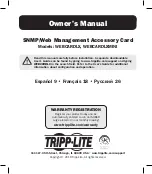
Nokia RoofTop™ Wireless Routing Installation Guide
13
Outdoor Installation Procedures
2.6 Outdoor Installation Procedures
WARNING:
Use extreme caution when installing antennas in areas
with overhead power lines. Outdoor antennas and their supporting
masts, guy wires, and cables are electrical conductors. Contact with
high-voltage electrical wires can cause serious injury or death.
2.6.1 Safety Guidelines
•
Plan the entire procedure before starting
•
If necessary, obtain appropriate assistance
•
Wear a hard hat and gloves
•
Wear heavy toe boots to protect your feet from falling objects
•
Do not install antennas on windy or rainy days
•
Assemble the antenna components at or near the final site
•
Ground the antenna support structure prior to erecting the antenna
•
Firmly anchor the base of the support structure
•
Keep the antenna at least twice the mast height from power lines
•
If you start to drop an antenna, let it fall and back away from it
•
Installations must be performed by a professional
• Maintain
the required distance from the antenna
while the wireless router is on (for more information on the MPE
distance, please refer to Appendix D).
•
Install antennas at least six feet (two meters) above ground
2.6.2 Required Installation Components
•
RF cabling
•
Lightning protector
•
Antenna
Summary of Contents for RoofTop R242
Page 4: ......
Page 10: ...4 Nokia RoofTop Wireless Routing Installation Guide ...
Page 28: ...22 Nokia RoofTop Wireless Routing Installation Guide ...
Page 38: ...32 Nokia RoofTop Wireless Routing Installation Guide ...
Page 40: ...34 Nokia RoofTop Wireless Routing Installation Guide ...
Page 44: ...38 Nokia RoofTop Wireless Routing Installation Guide ...
















































